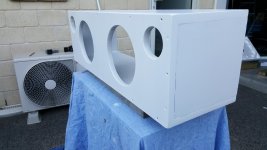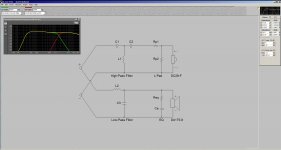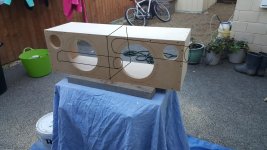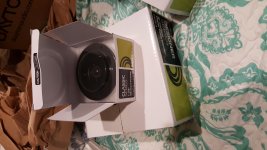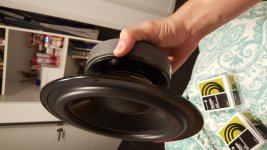I've got a 2x 2way set up and it need a bit of help to create a crossover
Here's the drivers
Woofer
https://www.parts-express.com/dayton-audio-ds215-8-8-designer-series-woofer-speaker--295-430
Tweeter
https://www.parts-express.com/dayton-audio-dc28f-8-1-1-8-silk-dome-tweeter--275-070
Also what kind of order (1st order butterworth etc)
Do I need to go with?
Here's what it the box looks like so far
Thanks in advance! Learning heaps from you guys 🙂
Here's the drivers
Woofer
https://www.parts-express.com/dayton-audio-ds215-8-8-designer-series-woofer-speaker--295-430
Tweeter
https://www.parts-express.com/dayton-audio-dc28f-8-1-1-8-silk-dome-tweeter--275-070
Also what kind of order (1st order butterworth etc)
Do I need to go with?
Here's what it the box looks like so far
Thanks in advance! Learning heaps from you guys 🙂
Attachments
Hi!
I have a couple of places you should start looking at. First, my blog post on crossovers for beginners.
Next, a thread here on measuring to create a two way speaker crossover.
Last, here's a link to XSim, a free tool to help you. You can import the Dayton data and at least start learning about what's needed. Once you measure your actual drivers in place you will import the measured data and replace that for most accurate results.
Best,
Erik
Lastly, make sure the two woofers have a divider between them to minimize driver and amplifier interactions.
I have a couple of places you should start looking at. First, my blog post on crossovers for beginners.
Next, a thread here on measuring to create a two way speaker crossover.
Last, here's a link to XSim, a free tool to help you. You can import the Dayton data and at least start learning about what's needed. Once you measure your actual drivers in place you will import the measured data and replace that for most accurate results.
Best,
Erik
Lastly, make sure the two woofers have a divider between them to minimize driver and amplifier interactions.
Awesome thanks for your help.
I was thinking about doing so with them both sharing the same port at the back of the box would this work or should I have have two separate ports, one for each woofer.
Also Should I put the tweeters in their own enclosures too?
Lastly, make sure the two woofers have a divider between them to minimize driver and amplifier interactions.
I was thinking about doing so with them both sharing the same port at the back of the box would this work or should I have have two separate ports, one for each woofer.
Also Should I put the tweeters in their own enclosures too?
Hi,
You really don't need a divider and the tweeters don't
need any separate enclosures. One port will be fine.
rgds, sreten.
You really don't need a divider and the tweeters don't
need any separate enclosures. One port will be fine.
rgds, sreten.
Sreten,
The issue I was worried about is feedback. If one driver is driven, but the other is not, the second will become a microphone and cause the amplifier to correct for it, as well as re-radiate the output of the other driver. So in a stereo configuration you can end up with some complicated driver and amplifier interactions.
Is it absolutely necessary? Meh, probably not. But I would do it that way, or I would use a single woofer and two tweeters, but this box already has the cut-outs. A worthwhile experiment would be to cut the box to allow for a divider and test the amplifier current as well as microphone measurements either way.
Best,
Erik
The issue I was worried about is feedback. If one driver is driven, but the other is not, the second will become a microphone and cause the amplifier to correct for it, as well as re-radiate the output of the other driver. So in a stereo configuration you can end up with some complicated driver and amplifier interactions.
Is it absolutely necessary? Meh, probably not. But I would do it that way, or I would use a single woofer and two tweeters, but this box already has the cut-outs. A worthwhile experiment would be to cut the box to allow for a divider and test the amplifier current as well as microphone measurements either way.
Best,
Erik
I can do the divider I have allowed room for it. It might be better off doing it whether it would make a difference or not. If I was going to do it, can they share the same port?
Last edited:
If you have 2 drivers driven by different signals (Left and Right or Hi and Low) they must not share the same acoustic space. So that means you need a divider to completely seal one off from the other, and if ported you'll need two ports.
Best,
Erik
Best,
Erik
Hi,
There is nothing wrong with adding the divider as a useful
brace, but in reality its not really strictly necessary IMO.
rgds, sreten.
FWIW bass is essentially mono. Any stereo information
essentially cancels in a room and is pretty pointless.
There is nothing wrong with adding the divider as a useful
brace, but in reality its not really strictly necessary IMO.
rgds, sreten.
FWIW bass is essentially mono. Any stereo information
essentially cancels in a room and is pretty pointless.
Last edited:
Bass may sound mono, but that doesn't mean it was recorded that way. It's the interactions inside the cabinet that concern me. Still, Meh!!
Not a strong opinion either way.
Best,
Erik
Not a strong opinion either way.
Best,
Erik
Parts Express has the FRD(frequency) and ZMA(impedance) data files for Dayton drivers which you can download. These are BIG BAFFLE measurements.
-You can download BoxSim + manual. A complete free toolset. Box + Crossover tool. BoxSim will modify FRD/ZMA/Phase based upon the box diffraction and crossover components.
-Download Passive Crossover Design Calculator 2.03 to calc early RLC values.
-Find a few example 2-way crossovers.... probably LR4 to avoid 2Khz woofer cone breakup, but also sim LR2 slope for low parts count(tweeter flips polarity).
-build-measure-tune-measure-celebrate.
-You can download BoxSim + manual. A complete free toolset. Box + Crossover tool. BoxSim will modify FRD/ZMA/Phase based upon the box diffraction and crossover components.
-Download Passive Crossover Design Calculator 2.03 to calc early RLC values.
-Find a few example 2-way crossovers.... probably LR4 to avoid 2Khz woofer cone breakup, but also sim LR2 slope for low parts count(tweeter flips polarity).
-build-measure-tune-measure-celebrate.
BoxSim frustrates everyone for about four 2-hour sessions. Short manual plus trial and error. There are BoxSim threads on diyAudio, and a forum. A library with about 50 speaker projects(Google search). BoxSim startup has a 2-way example that allows you to easily experiment with making changes to the box size, driver position on the baffle, and crossover circuit. You have the T/S parameters + FRD + ZMA for the two Dayton drivers, and can add them to your BoxSim database to start your design. BoxSim will generate Xover circuits based upon the ZMA file data(BW3, LR2, BW2, etc..), the Passive Crossover spreadsheet is just an alternative tool and some good notch filters.
The Dayton DC28f-8 datasheet on PartsExpress has a 834Hz resonance, with a recommended crossover above 1800Hz. BUT your midrange starts major breakup around 2Khz, so a steep LR4 slope at 1600Hz is a good first experiment. You should also experiment with 1800Hz and listen for woofer grunge.
I attached an example LR4 topology for SB Acoustic drivers I had on hand, and an example crossover for the DC28f-8 from Google search.
The Dayton DC28f-8 datasheet on PartsExpress has a 834Hz resonance, with a recommended crossover above 1800Hz. BUT your midrange starts major breakup around 2Khz, so a steep LR4 slope at 1600Hz is a good first experiment. You should also experiment with 1800Hz and listen for woofer grunge.
I attached an example LR4 topology for SB Acoustic drivers I had on hand, and an example crossover for the DC28f-8 from Google search.
Attachments
Awesome.
Thanks for your time linesource.
Sweet is good all the info about my speakers are out there and easy to find. Il download that program this weekend and have a look. What do you think about a divider between left and right channels and high and low?
Thanks for your time linesource.
Sweet is good all the info about my speakers are out there and easy to find. Il download that program this weekend and have a look. What do you think about a divider between left and right channels and high and low?
Last edited:
It is very important to add a solid divider between L-R woofers in order to maintain some stereo imaging. The divider board is also a good brace to reduce resonances,
Ok cool do you think that if I put the port going from left acoustic space to the right side of the box and right side to the left like shown in the pic.
Also my speakers arrived today!
Also my speakers arrived today!
Um, what??
The ports should not be shared, and they should go from inside to outside. Definitely not across one space to the other.
Now whether they point forwards, back or down is all up to you. 🙂
Best,
Erik
The ports should not be shared, and they should go from inside to outside. Definitely not across one space to the other.
Now whether they point forwards, back or down is all up to you. 🙂
Best,
Erik
No no no haha not like that I mean left channels port goes out the right side of the box like the photo. I was wondering if it would be ok to have the left channels port coming out the right and the right channels port coming out the left 🙂
Are your ports actually that long ???? Just to be sure, did you actually run the numbers and get a port requirement that big?
Normally if you really needed a port that long (based on cabinet calculations) you'd fold them. You could do it as you show, with a little loss to any vibrations transmitted by the ports to the opposite drivers, but it's passable.
Erik
Normally if you really needed a port that long (based on cabinet calculations) you'd fold them. You could do it as you show, with a little loss to any vibrations transmitted by the ports to the opposite drivers, but it's passable.
Erik
I use this webaite to calculate Car Audio - PORT Size Calculations and Formulas for WOOFER and Subwoofer BOXES
I think it's correct.
Box .60 ft3
Tuning freq.52 hertz
3.5 inches diameter
13.42 inches long
I think it's correct.
Box .60 ft3
Tuning freq.52 hertz
3.5 inches diameter
13.42 inches long
- Status
- Not open for further replies.
- Home
- Loudspeakers
- Multi-Way
- 2 way crossover help
